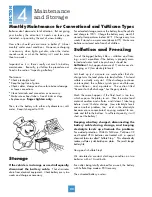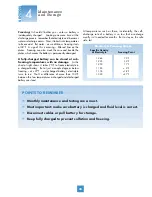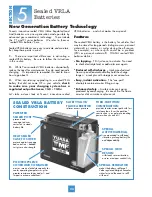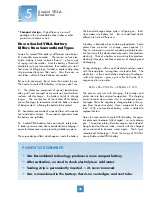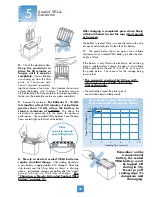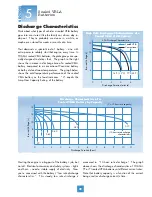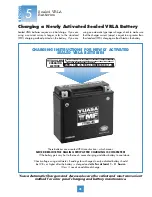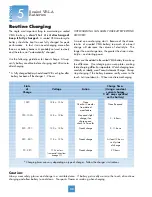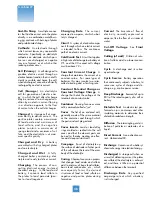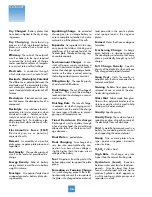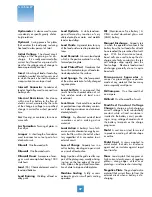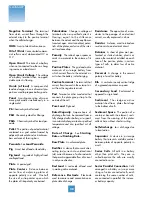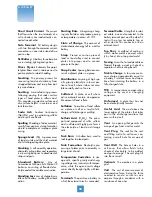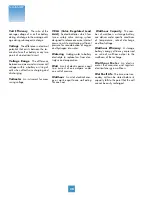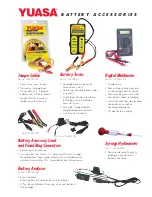
Cast-On Strap
A multiple connec-
tor that had been cast onto the plates
directly in a combination mold/burn-
ing jig; contrasts with burning of plates
and prefabricated straps.
Cathode
An electrode through
which current leaves any non-metallic
conductor. Specifically, an electrolytic
cathode is an electrode at which posi-
tive ions are discharged, or negative
ions are formed, or at which other
reducing actions occur.
Cell (Primary)
A cell designed to
produce electric current through an
electrochemical reaction that is not effi-
ciently reversible and hence the cell,
when discharged, cannot be efficiently
recharged by an electric current.
Cell (Storage)
An electrolytic
cell for generation of electric ener-
gy, in which the cell after discharge
may be restored to a charged con-
dition by an electric current flowing
in a direction opposite to the flow
of current when the cell discharges.
Charged
A storage cell at maxi-
mum ability to deliver current. The
positive plates contain a maximum
of lead oxide and a minimum of
lead sulfate, and the negative
plates contain a maximum of
sponge lead and a minimum of sul-
fate, and the electrolyte is at maxi-
mum specific gravity.
Charged and Dry
A battery
assembled with dry,charged plates
and no electrolyte.
C h a r g e d a n d We t
A fully-
charged battery containing elec-
trolyte and ready to deliver current.
Charging
The process of con-
verting electrical energy to stored
chemical energy. In the lead acid
battery, it converts lead sulfate in
the plates to lead peroxide (posi-
tive) or lead (negative).
Charging Rate
The current,
expressed in amperes, at which a bat-
tery is charged.
Circuit
A system of electrical compo-
nents through which an electric current
is intended to flow. The continuous
path of an electric current.
Cold Crank Test
A test that applies
a high rate of discharge to a battery at
0°F, and the 30 second cell voltage
must be above 7.2v.
Constant Current Charge
A
charge that maintains the current at a
constant value. For some types of
batteries this may involve two rates,
called a starting and a finishing rate.
Constant Potential Charge or
Constant Voltage Charge
A
charge that holds the voltage at the
terminals at a constant value.
Container
Housing for one or more
cells, commonly called a “jar.”
Cover
The lid of an enclosed cell,
generally made of the same material
as the container and through which
the posts and vent plug extend.
Cover Inserts
Lead or lead alloy
rings molded or sealed into the cell
cover, and that the element posts are
burned to, thereby creating an effec-
tive acid creep-resistant seal.
Creepage
Travel of electrolyte up
the surface of electrodes of other parts
of the cell above the level of the main
body of the electrolyte.
Curing
Chemical conversion process
that changes lead oxides and sulfuric
acid to mixtures of basic lead sulfates,
basic lead carbonates, etc., which
consequently forms the desired
structures of lead or lead sulfate on
negative and positive plates during
formation.
Current
The time rate of flow of
electricity, normally expressed as
amperes, like the flow of a stream of
water.
Cut-Off Voltage
See
Final
Voltage.
Cutting (of acid)
Dilution of solu-
tion of sulfuric acid to a lower concen-
tration.
Cycle
A discharge and its subse-
quent recharge.
Cycle Service
Battery operation
that continuously subjects a battery to
successive cycles of charge and dis-
charge, e.g., motive power service.
Deep Discharge
Removal of up to
80% of the rated capacity of a cell or
battery.
Dielectric Test
An electric test per-
formed on jars, containers and other
insulating materials to determine their
dielectric breakdown strength.
Diffusion
The intermingling or distri-
bution of particles or molecules of a
liquid.
Direct Current
A one-direction cur-
rent. Abbreviated
DC.
Discharge
Conversion of a battery’s
chemical energy into electrical energy.
Discharged
A storage cell when, as
a result of delivering current, the plates
are sulfated, the electrolyte is exhaust-
ed, and there is little or no potential
difference between the terminals.
Discharge Rate
Any specified
amperage rate at which a battery
is discharged.
35
GLOSSARY
Summary of Contents for SmartShot Automatic 12V 1.5 Amp 5 Stage
Page 1: ......


